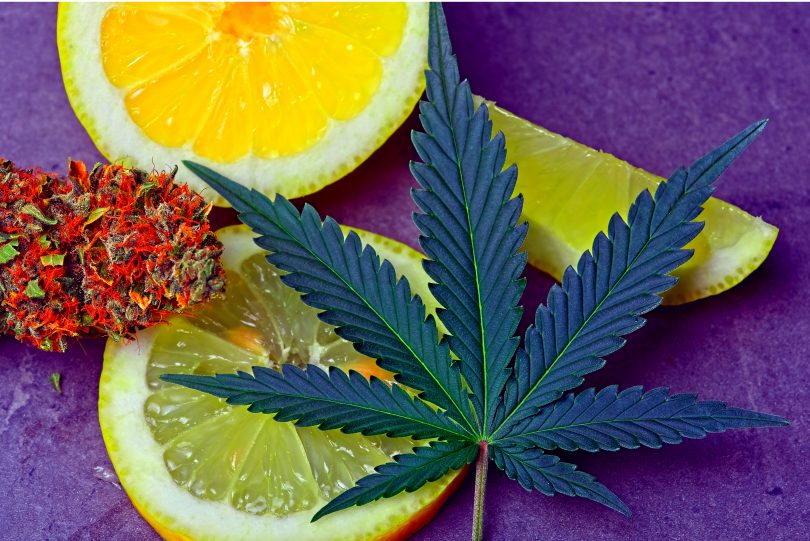While the human body is permanently trying to bring itself to a state of equilibrium – known as homeostasis – there are numerous external factors to consider, plant compounds known as Terpenes are on that list.
The human body will stop at nothing to keep itself balanced and in check. There are numerous intricate systems inside the body which control different things, whether that be health, feelings of well-being, sleep, or appetite. That intricate process is known as homeostasis, and it can be impacted by a variety of things including plant terpenes.
Homeostasis refers to balance in the body and include the regulation of multiple internal functions like body temperature, blood glucose levels, appetite and metabolism, sleep/wake cycles, and breathing patterns, to name a few. Three organs in the body are mainly responsible for bringing the body to homeostasis:
- Brain – The human brain is intricately involved in every process in the body. The brain controls various aspects of homeostasis within the hypothalamus or the endocrine system.
- Liver – The liver controls the metabolism of carbohydrates and well as numerous other functions vital for keeping the body in harmony.
- Kidneys – The kidneys control several different things inside the body, including blood water levels, salt levels, and a balanced pH in the blood.
The human body also has collections of glands located in different places, which play a vital role in encouraging the body to a state of homeostasis:
- Endocrine System – This system inside the body consists of glands which produce hormones used to regulate things like sleep, sexual function, mood, metabolism, growth, and many other things. Glands located in the endocrine system include the thyroid gland, pituitary gland, testicles, ovaries, pancreas, adrenal glands, and parathyroid glands. This system is involved in absorbing things from the bloodstream, processing them and then releasing only those hormones that are needed most back into the bloodstream. These hormones are one of the main things that bring the body to homeostasis.
- Neuroendocrine System – Can be described as multiple sets of neurons, glands and non-endocrine tissues, and the neurochemicals, hormones, and humoral signals they produce and receive, that work together to help regulate the body. Many cells in the neuroendocrine system produce hormones as a response to various neurological signals.
While these two systems are primarily responsible for homeostasis, they cannot work alone. Other systems inside humans, such as the endocannabinoid system (ECS) also regulates various functions in the body. That’s why many scientists believe that as humans evolved alongside plant life for so long, various chemicals and compounds from some plants effectively maintain and even boost these systems to the point of equilibrium or perfect balance. One of those chemicals is terpenes.
Terpenes Explained

Commonly found in hops and bay leaves
Terpenes are officially a “secondary metabolite produced by plants.” That means in laymen’s terms that some plants produce chemicals that play no part in the reproduction or growth of the plant itself. These metabolites are not only beneficial for the plant, they do interact in surprising ways with humans. Terpenes are thought to be beneficial for the treatment of a variety of ailments that humans suffer from, like anxiety, pain, and insomnia.
Terpenes are in many things, from oranges to lemons to various trees like conifers. Terpenes are what give a fruit, vegetable, plant, or tree its unique smell. Terpenes have been extracted to make essential oils for years and are used inside beauty products and even cleaning products to give them a “natural” aroma.
Take aromatherapy, for example, whereby essential oils packed with terpenes are diffused into the air. These terpenes are subsequently inhaled in large amounts and then bind to receptors, encouraging various internal systems to reach homeostasis. Terpenes affect the endocannabinoid system, the endocrine system, and the neuroendocrine system. The way that terpenes interact with humans is quite fascinating.
Terpenes and Homeostasis in Humans
To date, scientists have identified around 200 different terpenes. Each terpene affects humans in specific ways, even though we don’t precisely understand that mechanism. Terpenes target various receptors and neurotransmitters, with the most well-known being alpha-pinene, myrcene, and limonene.
These terpenes are inside some varieties of cannabis and are considered to be intricately involved in encouraging and activating receptors in both the endocannabinoid and neuroendocrine systems. Terpenes are believed to make those systems more active and assist in bringing the body to that ideal state of homeostasis.
Maintaining homeostasis with things like terpenes is a great way to keep the delicate systems of the body in check. For example, many medical experts believe that terpenes encourage homeostasis and can help to ward off things like anxiety and depression. However, different terpenes have varying effects. Some help to increase energy, reduce stress, and strengthen the immune system; others help to relieve inflammation and pain. That’s why many people even go as far as to say that people need terpenes, in the right amounts, to truly reach that ultimate goal of homeostasis.
Terpenes in Cannabis
We’re taking a look at five of the most common and best-known terpenes in the cannabis plant:
-

Commonly found in conifer trees
Myrcene – The scientific name for Mycrene is β-myrcene, and it happens to be the most common terpene in cannabis. It smells musky and earthy and is also highly fragrant. Myrcene is associated with a sedative body sensation and is mainly present in Indica cannabis varieties related to sleep. Myrcene also allows various cannabis compounds to enter the system more rapidly. Myrcene is also a potent analgesic, has anti-inflammatory properties, and is antibiotic. - Pinene – Pinene is probably the second most popular terpene when it comes to cannabis. It derives its name due to its aroma of pine and fir but is split into two varieties. There’s α-pinene and β-pinene, and both are vital components of pine resin. Pinene is used as an effective anti-inflammatory, expectorant, bronchodilator, and local antiseptic. Pinene is also used in Traditional Chinese Medicine and is believed to soften the effects of THC for some people.
- Limonene – Limonene is characterized by its lemony scent but is in reality formed from pinene. Cannabis strains containing an abundance of limonene smell citrusy and offer an uplifting and creative effect. Limonene also enhances mood and makes its way rapidly into the bloodstream. Limonene is also known to kill fungi and bacteria and is used for that purpose in essential oils applied to the skin.
- Linalool – Linalool is another popular terpene found in cannabis. Many describe linalool as having a flowery, lavender aroma, and it’s used by people wanting to feel calm and relaxed. Many cultures have used linalool for centuries as a sleep aid. It’s also used to temper any anxiety potentially caused by too much THC. Studies have shown that linalool boosts the immune system and restores cognitive and emotional function.
- Terpinolene – Terpinolene is more on the herbal side of things. It gives off the aroma of sage and rosemary and is used in the production of soaps, perfumes, and hair products. Terpinolene is a central nervous system depressant and is used to encourage drowsiness and to reduce overexcitement or panic attacks. Research is also underway to look at the connection between Terpinolene and various forms of cancer.
Terpenes as Medicine
The internal systems inside the body discussed in this article are vital for health and wellbeing and shouldn’t be underestimated. Terpenes have some remarkable effects on humans, and the symbiotic relationship between humanity and plants is a wonder. Terpenes are already used in pharmaceutical and alternative medicines alike and not just to make floor cleaner smell citrusy. Terpenes are associated with homeostasis in a big way, and there are two main ways to take terpenes into the body; aromatherapy, and natural.
It may sound strange, but there’s a scientific reason why people feel good after a brisk stroll the forest. The so-called practice of “forest bathing” is effective as you passively breathe in natural terpenes from trees like pine and fir. Terpenes are entering the lungs the whole time, and this is why it’s a great way to unwind and ward of anxiety and depression. It’s also the reason why people usually get a good night’s sleep after a long time spent in the fresh air, and that’s partially thanks to terpenes.
The other way to enjoy terpenes is via the aromatherapy method. Many people use specially formulated essential oils, for example, to deal with symptoms of Seasonal Affective Disorder (SAD). Certain oils containing various terpenes and other ingredients boost serotonin and make some people feel generally better. There is a third and more controversial way of taking terpenes, and that’s via cannabis.
Having been prohibited for decades across the world, despite recent legalization of the plant in certain parts of the world, there’s still a stigma when it comes to cannabis. THC is the compound inside the plants that make you high or stoned. CBD is another of the main compounds in cannabis that has no psychoactive effects and can be mixed with terpenes which are reintroduced to the extracted CBD.
CBD with Terpenes

Typically found in lemons and other citrus fruit
One of the best ways to take terpenes is through a CBD extract suspension such as CBD oil. There are three main types of CBD extract; Broad spectrum, Full spectrum, and Isolate. CBD Isolate contains only 100% pure CBD, and that’s great if you want to target the endocannabinoid system and nothing else. However, Broad-spectrum CBD contains CBD and terpenes, but no THC. Full-spectrum CBD can contain THC at levels higher than 0.3%.
Many companies produce and sell various CBD oils and vape juices containing different terpenes. It’s simple to find these products online or in retail stores, and you can often choose the specific strain and terpenes in the product you buy. CBD and terpenes are a natural and logical union as they cover so much ground when combined. While CBD is known to influence the ECS in positive ways, in the direction of homeostasis, terpenes, as mentioned above, also help to balance both the Endocrine and Neuroendocrine systems simultaneously, as well as the ECS.
Final Thoughts
The evidence that cannabis is a good thing for the immune system and for specific autoimmune diseases is mounting. However, there is some evidence to suggest that (cannabis) terpenes such as beta-caryophyllene decrease inflammation through its ability to stimulate the CB2 receptor. Another terpene, as discussed, Myrcene, is also known to have anti-inflammatory properties associated with some autoimmune conditions.
Further research is needed to establish precisely how terpenes affect the immune system. More studies also need to be carried out on the relationship between the so-called “entourage effect,” as far as cannabis and terpenes are concerned. If you want to delve deeper into the world of terpenes from a medical research perspective, check out the sources below linking to articles on the NCBI website.
Sources:
-
- Plant terpenes: defense responses, phylogenetic analysis, regulation, and clinical applications – Bharat Singh- and Ram A. Sharma2 – https://www.ncbi.nlm.nih.gov/pmc/articles/PMC4362742/
- Targeting Cannabinoid Signaling in the Immune System: “High”-ly Exciting Questions, Possibilities, and Challenges – Attila Oláh, Zoltán Szekanecz, and Tamás Bíró – https://www.ncbi.nlm.nih.gov/pmc/articles/PMC5686045/
- Terpenes from Forests and Human Health – Kyoung Sang Cho, Young-ran Lim, Kyungho Lee, Jaeseok Lee, Jang Ho Lee, and Im-Soon Lee –https://www.ncbi.nlm.nih.gov/pmc/articles/PMC5402865/







